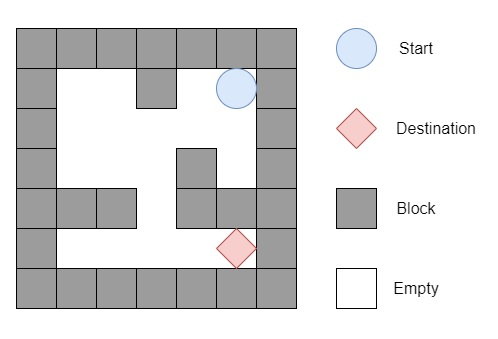
 Data Structure
Data Structure Networking
Networking RDBMS
RDBMS Operating System
Operating System Java
Java MS Excel
MS Excel iOS
iOS HTML
HTML CSS
CSS Android
Android Python
Python C Programming
C Programming C++
C++ C#
C# MongoDB
MongoDB MySQL
MySQL Javascript
Javascript PHP
PHP
- Selected Reading
- UPSC IAS Exams Notes
- Developer's Best Practices
- Questions and Answers
- Effective Resume Writing
- HR Interview Questions
- Computer Glossary
- Who is Who
The Maze II in C++
Suppose there is a ball in a maze with empty spaces and walls. Now the ball can go through empty paths by rolling any direction like up, down, left or right, but it won't stop rolling until hitting a wall. When the ball stops, it could choose the next direction.
We have to start position of ball, the destination and the maze, we have to find the shortest distance for the ball to stop at the destination. Here the distance is actually defined by the number of empty cells, that are covered by the ball (Excluding start position, including starting position). If that is impossible to stop the ball at destination, then return -1.
The maze is represented by one 2D array. Here 1 indicates the wall and 0 indicates the empty space. The borders of the maze are all walls. The start and destination coordinates are represented by row and column indices.
So, if the input is like a maze represented by a 2D array
| 0 | 0 | 1 | 0 | 0 |
| 0 | 0 | 0 | 0 | 0 |
| 0 | 0 | 0 | 1 | 0 |
| 1 | 1 | 0 | 1 | 1 |
| 0 | 0 | 0 | 0 | 0 |
start position is (0, 4) destination position is (4, 4), then the output will be 12, One possible way is : left to down to left to down to right to down to right. (1+1+3+1+2+2+2) = 12

To solve this, we will follow these steps −
n := row count, m := column count
ret := infinity
Define one 2D array dist of order n x m
Define one queue q
insert start into q
dist[start[0], start[1]] := 0
-
while (not q is empty), do −
curr := first element of q
delete element from q
x := curr[0], y := curr[1]
-
if x is same as destination[0] and y is same as destination[1], then −
ret := minimum of ret and dist[x, y]
currDist := dist[x, y]
tempDist := 0
i := x
-
while (i + 1 < n and grid[i + 1, y] is zero), do −
(increase i by 1)
(increase tempDist by 1)
-
if currDist + tempDist < dist[i, y], then −
dist[i, y] := currDist + tempDist
insert { i, y } into q
i := x
tempDist := 0
-
while (i - 1 >= 0 and grid[i - 1, y] is zero), do −
(increase tempDist by 1)
(decrease i by 1)
-
if currDist + tempDist *lt; dist[i, y], then −
dist[i, y] := currDist + tempDist
insert { i, y } into q
i := y
tempDist := 0
-
while (i - 1 >= 0 and grid[x, i - 1] is zero), do −
(decrease i by 1)
(increase tempDist by 1)
-
if currDist + tempDist < dist[x, i], then −
dist[x, i] := currDist + tempDist
insert { x, i } into q
i := y
tempDist := 0
-
while (i + 1 < m and grid[x, i + 1] is zero), do −
(increase i by 1)
(increase tempDist by 1)
-
if currDist + tempDist < dist[x, i], then −
dist[x, i] := currDist + tempDist
insert { x, i } into q
return (if ret is same as inf, then -1, otherwise ret)
Example
Let us see the following implementation to get better understanding −
#include <bits/stdc++.h>
using namespace std;
class Solution {
public:
int shortestDistance(vector<vector<int<>& grid, vector<int<& start, vector<int<& destination) {
int n = grid.size();
int m = n? grid[0].size() : 0;
int ret = INT_MAX;
vector < vector <int< > dist(n, vector <int<(m, INT_MAX));
queue < vector <int< > q;
q.push(start);
dist[start[0]][start[1]] = 0;
while(!q.empty()){
vector <int< curr = q.front();
q.pop();
int x = curr[0];
int y = curr[1];
if(x == destination[0] && y == destination[1]){
ret = min(ret, dist[x][y]);
}
int currDist = dist[x][y];
int tempDist = 0;
int i = x;
while(i + 1 < n && !grid[i + 1][y]){
i++;
tempDist++;
}
if(currDist + tempDist < dist[i][y]){
dist[i][y] = currDist + tempDist;
q.push({i, y});
}
i = x;
tempDist = 0;
while(i - 1 >= 0 && !grid[i - 1][y]){
tempDist++;
i--;
}
if(currDist + tempDist < dist[i][y]){
dist[i][y] = currDist + tempDist;
q.push({i, y});
}
i = y;
tempDist = 0;
while(i - 1 >= 0 && !grid[x][i - 1]){
i--;
tempDist++;
}
if(currDist + tempDist < dist[x][i]){
dist[x][i] = currDist + tempDist;
q.push({x, i});
}
i = y;
tempDist = 0;
while(i + 1 < m && !grid[x][i + 1]){
i++;
tempDist++;
}
if(currDist + tempDist < dist[x][i]){
dist[x][i] = currDist + tempDist;
q.push({x, i});
}
}
return ret == INT_MAX ? - 1 : ret;
};
main(){
Solution ob;
vector<vector<int<> v = {{0,0,1,0,0},{0,0,0,0,0},{0,0,0,1,0},{1,1,0,1,1},{0,0,0,0,0}};
vector<int< v1 = {0,4}, v2 = {4,4};
cout << (ob.shortestDistance(v, v1, v2));
}
Input
{{0,0,1,0,0},{0,0,0,0,0},{0,0,0,1,0},{1,1,0,1,1},{0,0,0,0,0}}, {0,4},{4,4}
Output
12

